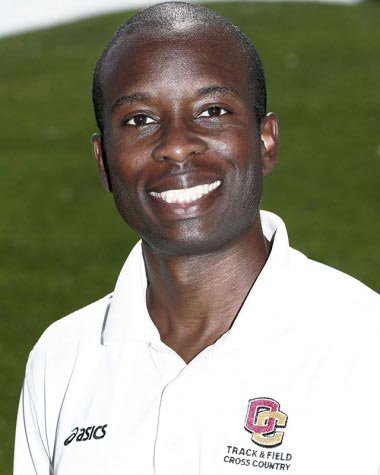In the Locker Room with Jason Hudson

Jason Hudson
May 1, 2015
This week, the Review sat down with Director of Student-Athlete Services and Wellness Jason Hudson to discuss his role in the Athletics department, coaching track and field and teaching fitness classes.
As Director of Student-Athlete Services, what are your primary responsibilities?
Jason Hudson: My primary responsibility is to make sure that all of our student-athletes are doing well. I provide links to other parts of campus if students need those. Ideally, [I] help students get nominated and awarded scholarships, like NCAA post-graduate scholarships and things of that nature. If students start to struggle in any way — academically, emotionally — [I] also try to wrap services around them to help them be successful that way as well.
Can you give examples of the types of services you might direct students to?
JH: Career services, in the sense of taking care of life after college but also getting internships. The Counseling Center, Student Academic Services, Disability Services. A lot of services that are within the dean’s office that a lot of people don’t know about. The class dean’s office has a lot of emergency services that are available that they don’t generally advertise, but when students need those types of things then we can loop them into those.
You are also an assistant coach on the track and field team. How does this compare to your other responsibilities in the department?
JH: In a way, the services that I provide to all student-athletes as director of Student-Athlete Services are what I already provide to the track team. It’s just sort of broadening the scope.
This year, you also began your work as director of Wellness. What is different about this position and being director of Student-Athlete Services?
JH: It’s another hat that I put on. I started that this year, so director of Wellness for students but also for faculty and staff. Students need to be healthy, so trying to offer more classes that students actually want to take at the times that they want to take them. Obviously we are building a health and wellness center that will help, but we need to have the offerings that are going to service the people. For faculty and staff, it’s finding times that they can do things, like offering classes at different times — earlier in the morning, later in the evening. Ideally, working with human resources and some of the upper administration to try to incentivise people to get healthier. The Cleveland Clinic gives people a break on their insurance if they average 10,000 steps [a day] per year. I’d like to do something like that here. If the Cleveland Clinic can do it, we certainly should be able to do it as well.
You teach Fitness for Life, Running and Conditioning and Independent Fitness this semester. Do you use similar workouts from track and field in these classes?
JH: They are very different, actually. There’s probably only one workout that crosses over. But in Fitness for Life and Independent Fitness we’re not necessarily running. We’re doing lots of circuits, we’re in the weight room and doing things of that nature.
Do you have a lot of student-athletes in your classes or is it usually people who don’t participate in sports on campus? How do you gauge how difficult to make the cases?
JH: Typically, it’s about one student-athlete a semester. The majority of students I have are Conservatory students, actually. At the beginning of each class, I ask them “What have you done recently?” and they fill out some questionnaires, and we go from there. People are at all different levels, some people are in great shape, and some haven’t done anything in months.
If you could improve one aspect of the Athletics Department, what would it be and why?
JH: I want everybody on this campus to feel like they can come into this building and feel safe and welcome, because right now it’s not that way, and that to me is unfortunate.
There have been some efforts recently to establish a safe-space hour for women and trans people in Philips. Is there a possibility of that happening in the future?
JH: It definitely is. I’ve had two conversations with folks about that, one earlier this week. The problem is space, because I know it happened in South gym, and it was quite successful from what they told me. The problem with the limited space that we have right now is — because we’re talking about the weight room — if we did that, we’re going to have to do it for other groups. We service so many people in this building — students, faculty and staff, community members — to shut it down for an hour can be problematic. When we have 12,000 extra square feet, we can close this for an hour because people then have the same space they can just go around the corner. So once we have the space, it’s an easy thing to do.
What is your favorite sport to watch?
JH: Football. I’m a Cowboys fan, so my dream Super Bowl would be the Texans vs. the Cowboys.

























